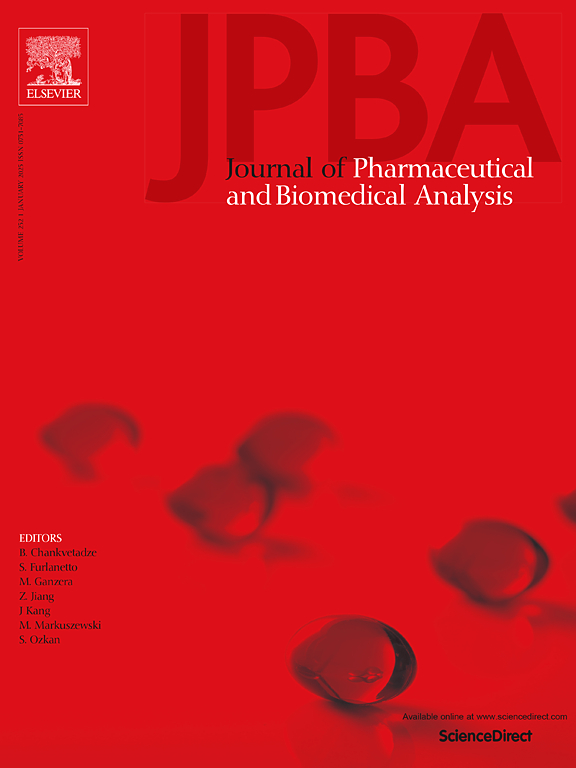Simultaneous analysis of various anticancer drugs by supercritical fluid chromatography-mass spectrometry. Part I: Optimization of chromatographic separation
IF 3.1
3区 医学
Q2 CHEMISTRY, ANALYTICAL
Journal of pharmaceutical and biomedical analysis
Pub Date : 2025-03-27
DOI:10.1016/j.jpba.2025.116838
引用次数: 0
Abstract
This work presents a generic SFC-MS method for the simultaneous analysis of 22 anticancer drugs (fluorouracil, busulfan, cyclophosphamide, cytarabine, dacarbazine, daunorubicin, docetaxel, doxorubicin, epirubicin, etoposide, gemcitabine, idarubicin, ifosfamide, irinotecan, methotrexate, paclitaxel, pemetrexed, raltitrexed, topotecan, treosulfan, vinblastine, vincristine). The separation conditions were optimized by screening nine stationary phases (2-picolylamine, bare hybrid silica, 2-ethylpyridine, fluoro-phenyl, octadecyl, diethylamine, diol, 1-aminoanthracene, zwitterionic modification), evaluating additives effects (2–5 % water, 20–50 mM ammonium formate, 0–1 mM ammonium fluoride), and adjusting the organic modifier composition (methanol, ethanol, isopropanol, acetonitrile). The optimized SFC-MS method successfully analyzed 22 anticancer drugs, along with 5 additional challenging compounds (azacitidine, mitomycin, cisplatin, oxaliplatin, carboplatin), in 12 min, using a diol column (100 × 3 mm, 1.7 µm) and a gradient of 2–100 % methanol containing 2 % water and 50 mM ammonium formate. To overcome overpressure generated by high organic solvent content, a backpressure gradient (110–150 bar) and a flow rate gradient (0.6–1.5 mL/min) were applied. The diol column was selected as the most promising based on five predefined chromatographic criteria. Additives with 5 % water or ammonium fluoride were excluded due to overpressure and signal loss, respectively. Increasing ammonium formate concentration improved peak symmetry by 29 %. For the organic modifier, pure methanol was chosen since ternary mixtures led to system overpressure without improving separation. Comparison with the LC-MS method using real samples confirmed the potential applicability of the SFC method, as the same trace compounds were detected with comparable concentrations. Sensitivity optimization and method validation will be discussed separately in a later paper.
求助全文
约1分钟内获得全文
求助全文
来源期刊
CiteScore
6.70
自引率
5.90%
发文量
588
审稿时长
37 days
期刊介绍:
This journal is an international medium directed towards the needs of academic, clinical, government and industrial analysis by publishing original research reports and critical reviews on pharmaceutical and biomedical analysis. It covers the interdisciplinary aspects of analysis in the pharmaceutical, biomedical and clinical sciences, including developments in analytical methodology, instrumentation, computation and interpretation. Submissions on novel applications focusing on drug purity and stability studies, pharmacokinetics, therapeutic monitoring, metabolic profiling; drug-related aspects of analytical biochemistry and forensic toxicology; quality assurance in the pharmaceutical industry are also welcome.
Studies from areas of well established and poorly selective methods, such as UV-VIS spectrophotometry (including derivative and multi-wavelength measurements), basic electroanalytical (potentiometric, polarographic and voltammetric) methods, fluorimetry, flow-injection analysis, etc. are accepted for publication in exceptional cases only, if a unique and substantial advantage over presently known systems is demonstrated. The same applies to the assay of simple drug formulations by any kind of methods and the determination of drugs in biological samples based merely on spiked samples. Drug purity/stability studies should contain information on the structure elucidation of the impurities/degradants.

 求助内容:
求助内容: 应助结果提醒方式:
应助结果提醒方式:


